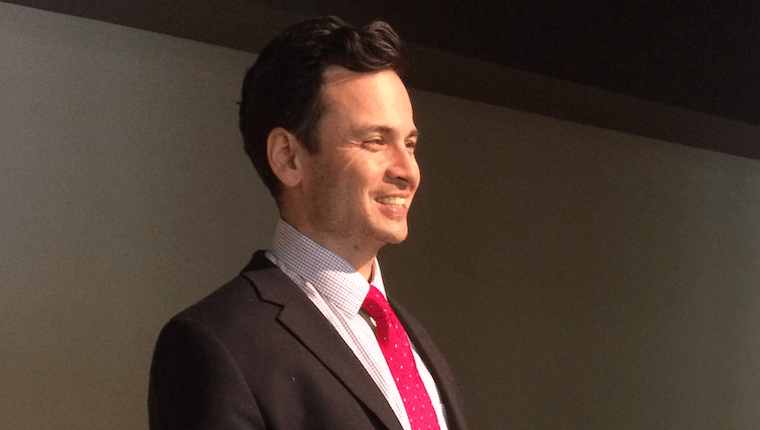Want to receive notification of special events and lectures? Sign up to receive email notifications.
Dr. Austin Chen on Hip Pain Causes and Relief
- Category: General, Orthopedics
- Posted On:
- Written By: Boulder Community Health

Does your hip hurt? Is it arthritis, a soft tissue injury or something else? Hip pain can have a number of different causes. Determining the right one is key to getting the best treatment and pain relief.
Is it Really Your Hip?
“When a patient tells me his or her hip hurts, the first thing I do is confirm that the hip is actually the problem,” orthopedic surgeon Dr. Austin Chen with BoulderCentre for Orthopedics told a crowd of 135 people during a free health lecture held on Jan. 7 in Boulder.
“Many people say they have hip pain, but what they’re experiencing might actually be pain in the lower back or the upper thigh or buttock,” he said. “Pain from a hip problem can be experienced in the front, side or back of the hip — or even in the knee.”
6 Common Causes of Hip Pain
According to Dr. Chen, here are some common culprits:
- Arthritis, particularly osteoarthritis, is among the most common causes of hip pain. “Arthritis is the inflammation and breakdown of the cartilage within the hip joint. The cartilage wears away and bone rubs against bone, causing pain, stiffness, and a reduced range of motion,” Dr. Chen explained.
- Femoroacetabular impingement (FAI) occurs when there’s a ridge or spur of extra bone on one or both of the bones in the hip joint. “The bones form an irregular shape and don’t correctly fit together during movement. Over time, this can damage the joint and lead to arthritis,” said Dr. Chen.
- Dysplasia is a structural abnormality. The hip is a ball-and-socket joint. In a normal hip, the ball at the upper end of the femur (thighbone) fits nicely in the socket. Dr. Chen explained that “when there’s dysplasia, the hip socket is shallow, causing inadequate stability to the hip joint and unequal forces through it.”
- Labral tear is a rip in the ring of cartilage, called the labrum, that acts like a rubber seal along the outside rim of the hip joint’s socket. Dr. Chen said that along with cushioning the hip joint, the labrum helps hold the ball of the femur securely in place.
- Greater Trochanteric Pain Syndrome (GTPS) refers to chronic regional pain that can be caused by a number of disorders, including bursitis — an inflammation of the small, jelly-like, fluid-filled sacs (bursa) that help decrease friction between the bone and the skin — or a strain on the muscles or tendons that support the hip.
- Snapping hip occurs when a muscle or tendon moves over a bony protrusion around or within the hip joint, creating a popping sensation or clicking sound in your hip when you walk or stand up from a chair. “While snapping hip is usually harmless, it can lead to painful bursitis or tendonitis,” Dr. Chen noted.
Conservative Treatments for Easing the Pain
Dr. Chen stated that treatment depends on the diagnosis but can include:
- Home remedies. Rest, heat or ice and over-the-counter anti-inflammatory medication can offer some pain relief for arthritis or GTPS. Also exercising the joint by engaging in low-impact activities (e.g., hiking, biking, swimming – but not breast stroke) can improve the hip joint’s health.
- Physical therapy, acupuncture and dry needling.
- Therapeutic injections:
• Steroid injections can reduce inflammation but tend to be more effective in treating arthritis than other types of hip problems.
• Hyaluronic acid injections, also known as “rooster shots,” can sometimes improve the joint’s gliding motion. However, they are FDA approved only for the knee.
• Platelet Rich Plasma (PRP) injections are composed of blood cells that help facilitate and enhance the healing of injured tissue.
• Stem cell therapy, an experimental treatment, might help repair damaged hip tissue, but its effectiveness is still being researched.
If Conservative Treatments Fail
“When these non-surgical treatments don’t offer pain relief, the next step to consider is surgery,” said Dr. Chen. “Hip preservation might be your best surgical option for FAI or labral tears and, in some cases, for instability and painful snapping. This is performed arthroscopically through three or four ‘key-hole’ size incisions.”
If hip replacement is needed, Dr. Chen stated that he tends to use a muscle-sparing, front-of-the-hip (anterior) approach to hip replacement. “I’ll access the hip joint by making a 3-to-4-inch incision at the front of the hip, near the groin, and gently push muscles aside rather than cutting them. This leads to a quicker, less painful recovery.”
He went on to describe BCH's Mako surgeon-controlled robotic arm and computer-guided navigation software to replace hip joints, which optimizes surgical results.
Dr. Austin Chen is dual-fellowship trained in hip and sports medicine surgery and specializes in hip preservation and replacement. To make an appointment with him, call 303-449-2730.
Click here to view PowerPoint slides from Dr. Chen’s lecture on "Relieving Hip Pain."